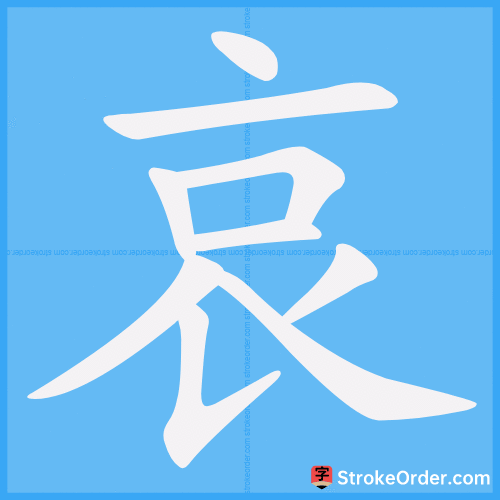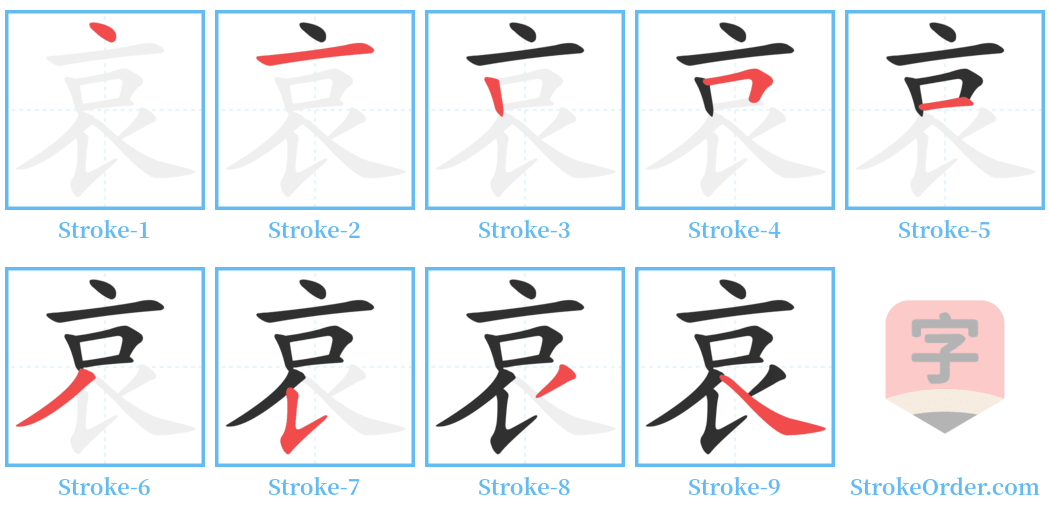哀 Stroke Order
Animated Stroke Order of 哀

Stroke Order Diagrams for 哀

Step-by-Step Handwriting Guide for 哀

Learn to Write Chinese Characters with Video Tutorials
Watch the video of writing the Chinese character "哀", learn the correct stroke order (笔顺) of the character "哀", and master the standard way of writing the character "哀".
Free Printable Handwriting Practice with Stroke Order: 哀
Printable Writing Practice Worksheet of "哀" in Portrait Orientation (Tian Zi Ge)

Printable Writing Practice Worksheet of "哀" in Landscape Orientation (Tian Zi Ge)

Information of 哀
Pinyin
āi
Radical
口
Strokes
9 strokes
Usage
★★★★★
Definition
sorrow / grief / pity / to grieve for / to pity / to lament
哀 [āi]
形 (Adjective):
1. 悲痛: grieved; sorrowful.
- 例: 悲~ (sorrowful), ~求 (to plead with sorrow), ~叹 (to sigh with grief), ~鸣 (to mourn), ~思 (to lament), ~鸿遍野 ("哀鸿", the mourning geese; metaphorically means everywhere there are weeping, displaced victims).
- ~艳 (the poetry is sorrowful yet moving and magnificent).
2. 悼念: to mourn; express condolences.
- 例: ~悼 (to grieve for), 默~ (to mourn silently).
3. 旧时称死去母亲: historically refers to a deceased mother.
- 例: ~子 (a. mother has passed away while father is still alive; b. an ancient term for someone in mourning for a parent).
动 (Verb):
1. 同情,怜悯: pity; sympathize with.
- 例: 君将哀而生之乎 (in "The Snake Catcher's Talk", suggests a sympathy to give birth).
2. 慰问; 哀悼: to express sympathy and solicitude for; to mourn.
- 例: 秦不哀吾之丧而伐吾同姓 (from "Zuo Zhuan", indicates a lack of mourning for a colleague).
3. 哀求: to supplicate; to beg.
- 例: 爱公者皆为公惧,劝罄橐以哀之 (from "Strange Tales from a Chinese Studio", which relates to begging).
4. 通“爱”: care for; cherish.
- 例: 国家虽弱,令必敬以哀 (from "Guanzhong", advises respect and care).
5. 哀叹: to bemoan; bewail.
- 例: 秦人不暇自哀,而后人哀之 ("The Epang Palace Fu" speaks of retrospective sorrow).
名 (Noun):
- 姓: a surname.
Note: The character 哀 represents profound emotions such as sorrow or grief, expressed in various contexts including expressions of sympathy and mourning rituals.
four types of human emotions, namely: happiness 歡喜|欢喜[huan1 xi3], anger 憤怒|愤怒[fen4 nu4], sorrow 悲哀[bei1 ai1] and joy 快樂|快乐[kuai4 le4]
Input Method for 哀
Pinyin
ai1
Wubi
yeu
Cangjie
yrhv
Zhengma
sjrh
Four Corner
00732
Unicode
U+54c0
Same Pronunciation Characters